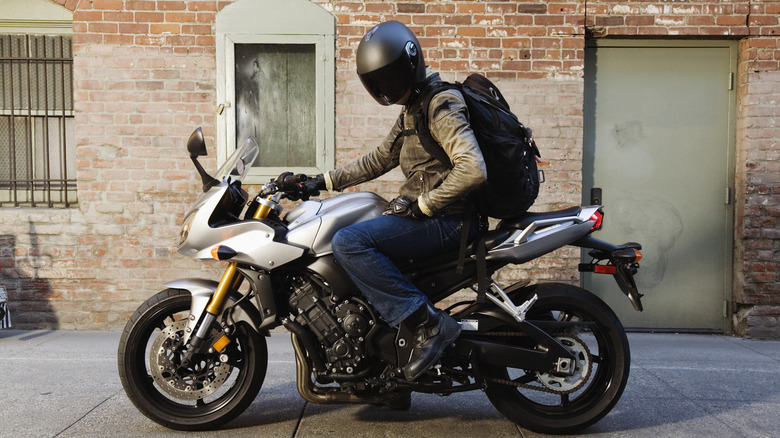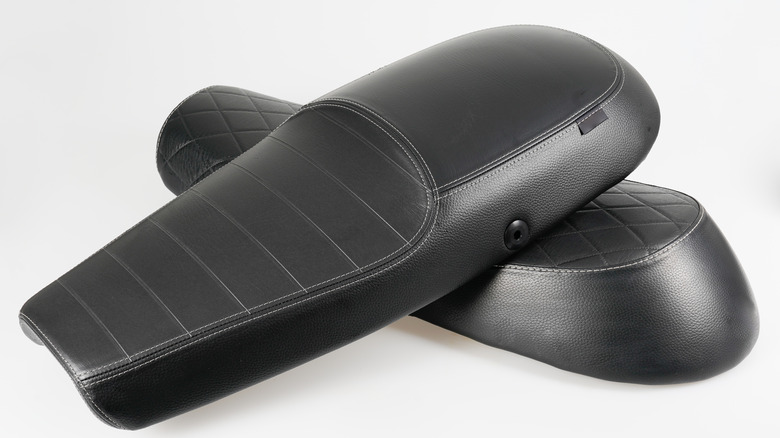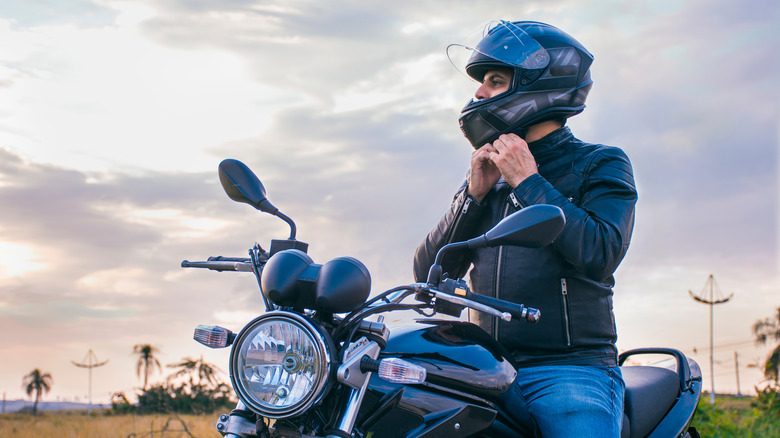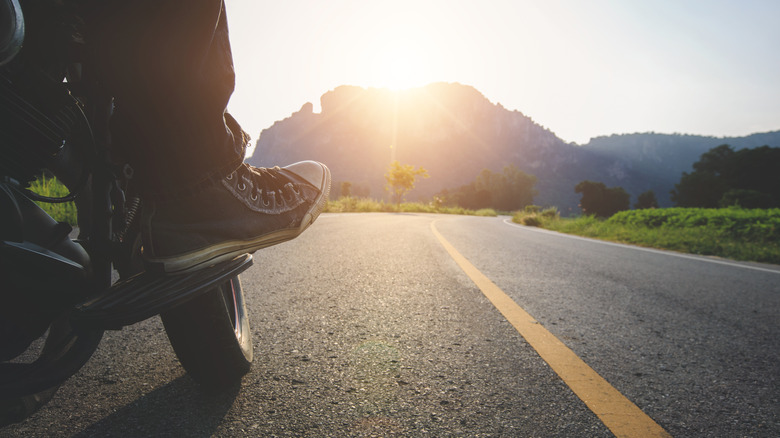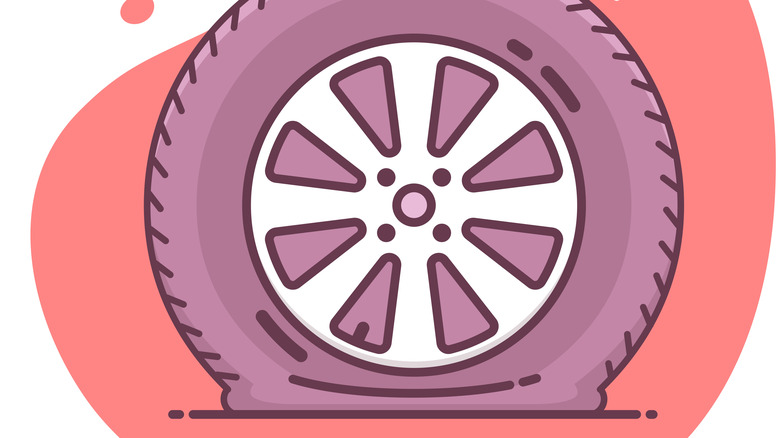5 Must-Have Motorcycle Gear And Accessories For Long-Distance Rides
Long-distance motorcycle adventures are brimming with spontaneity and the freedom of the open road. It's these aspects that call bikers back to the highway time and time again. Riders can't get enough of the magnificent sights and wind in their face. New riders who embark on a more extended voyage with friends will surely be hooked the first time they set out on a longer ride. Long-distance riding is such an integral part of the motorcycle-owning experience that those lucky enough to own a bike often buy one for that reason.
There's even a whole class of motorcycles (called touring models) that have been tailor-made to suit this type of long-distance adventure riding. Rather than prizing sleek designs and acceleration, touring motorcycles bring more lavish creature comforts to the saddle, incorporating larger gas tanks, more storage, and often adding comfortable pillion riding features behind the main seat.
Whether you own a touring model or a dirt bike, hitting the open road is a rewarding experience that can't be replicated in your backyard. Fortunately, there are many options for outfitting your bike for comfort, distance, and style, regardless of the motorcycle you drive.
Change out your bike's seat
The seat is the first thing you should change when outfitting a standard motorcycle for longer rides. An additional pad can offer increased comfort on a long journey and will only run you a few dollars.
However, to experience true luxury in a motorcycle seat, you might consider a complete replacement with memory foam or a plush padded upgrade. Instead of using an add-on pad for more comfort in your seat, installing a brand-new memory foam cushion will keep your riding posture the same, avoiding the need to adjust your riding style or physical approach to the task of driving.
If you are willing to make changes like this, opting for a seat that sees you sitting in a more upright position can also make a big difference on longer journeys. This can be achieved by changing out the seat for one that's shaped differently. Tweaking your handlebar positioning can also affect your posture. Sitting in a relaxed position that doesn't include a steep hunch over the bike's center will make for a more enjoyable riding experience. This will cost anywhere between just a few bucks to a few hundred. For that price, the overwhelming improvement in the long-distance riding experience is hard to beat.
Add a Bluetooth helmet system
A Bluetooth helmet system is an excellent option for motorcycle riders who want to enjoy the open road while listening to their favorite playlists, podcasts, or even voice directions from their phone or GPS. Bluetooth connectivity has made seamless access to many devices simple and intuitive. Today, motorcycle owners can integrate Bluetooth headphone devices into their helmets. Fiddling with an earbud underneath your head protection (and worrying about dropping it) isn't a part of the equation.
These tools also make taking calls a breeze without needing to stop to talk to someone. The long-distance driving experience is far more enjoyable with the help of this entertainment, communication, and guidance accessory.
Regarding ear gear, you might also consider using a set of earplugs to minimize road noise. If you're spending hours each day cruising down the highway, the constant drone that emanates from your bike's tires can take away from the peacefulness and enjoyability of the ride. A set of earplugs can make for a more mindful and wholesome experience and offers a change of pace when the road is too demanding.
Install new, larger foot pegs
A few key factors influence your seated position — one of them is your feet, and this lower point of contact plays a significant role in overall comfort while on the roadway. Small foot pegs can be forgiven on a racer-style motorcycle that prizes sleek lines and a trim silhouette over other stylistic options for a short ride. However, on a bike you intend to tour, large foot pegs that offer mobility and adjustability in your grip are vital installations.
Larger foot pegs will allow you to readjust your positioning on the motorcycle freely while riding. A wider foot peg is also a good option for bikers who do a lot of off-road driving. The increased surface area gives an off-road enthusiast a better grip on the vehicle while traversing the wild landscape beneath their wheels.
You might also consider repositioning where your existing pegs are located. A change in the layout of your pegs will shift the way your legs bend when you saddle up. This can drastically increase or decrease the strain that your body experiences while exploring your next long-distance adventure.
Bring along an emergency communication system
Many riders utilize their phones as GPS and communication outlets while riding. For the best experience with your phone as a navigational device, it's a good idea to consider a vibration-dampening mount accessory.
You may also run into more dire situations in which your phone isn't sufficient. If you're involved in an accident, puncture a tire in an area with poor reception, or run out of gas, a more substantial SOS signaling resource is necessary. That's why many long-distance riders never leave home without an emergency communication system to back up their existing calling capabilities. Emergency communicators often utilize satellite relays and come packed with either extensive two-way communication features or a single button that works almost anywhere.
Whatever your preference, it's essential that you bring this piece of gear along with you anytime you head off on a road trip. The knowledge that you can call for help and that the message will be received no matter your geographic circumstances is powerful. It allows you to ride without worrying about a mishap, giving you the freedom to enjoy the road and the journey.
A flat repair kit and air compressor
Finally, all motorcyclists should pack an emergency tire repair kit. Unlike a car, your motorcycle doesn't have a compartment for a spare tire. Therefore, riders must take care of their wheels and fix them as soon as a problem arises. The typical touring tire uses belts or cords inside and a purpose-built hardened outer layer to take a lot of punishment from the many miles of roadway between a rider and their completed voyage.
This means repairing and reinflating a tire is possible under most circumstances. A flat repair kit is a reasonably small addition to your bike's storage compartments and should always be carried — even while traversing local roadways or during your daily commute.
A portable air compressor is a little more cumbersome, but it can save you from a serious headache and many hours of derailment in the event of a puncture. Fixing and reinflating a flat tire is a job that will only take minutes if you bring the appropriate equipment.
